That'll 'learn ya' Stathi!! Here's another piece of gratuitous advice: ignore modern rewrites by people who dismiss uncomfortable inscriptional evidence because it doesn't fit a cherished belief.Taphoi wrote:Here's an idea: why not ignore modern historical re-writes by people who have not even bothered to read all the ancient accounts of Hephaistion's funeral and go and read all the ancient accounts instead and make up your own mind about what happened?
The Sphinxes Guarding the Lion Tomb Entrance at Amphipolis
Moderator: pothos moderators
Re: The Sphinxes Guarding the Lion Tomb Entrance at Amphipolis
Paralus
Ἐπὶ τοὺς πατέρας, ὦ κακαὶ κεφαλαί, τοὺς μετὰ Φιλίππου καὶ Ἀλεξάνδρου τὰ ὅλα κατειργασμένους;
Wicked men, you sin against your fathers, who conquered the whole world under Philip and Alexander.
Academia.edu
Ἐπὶ τοὺς πατέρας, ὦ κακαὶ κεφαλαί, τοὺς μετὰ Φιλίππου καὶ Ἀλεξάνδρου τὰ ὅλα κατειργασμένους;
Wicked men, you sin against your fathers, who conquered the whole world under Philip and Alexander.
Academia.edu
- Efstathios
- Hetairos (companion)
- Posts: 759
- Joined: Wed Jun 15, 2005 8:08 pm
- Location: Athens,Greece
Re: The Sphinxes Guarding the Lion Tomb Entrance at Amphipolis
I suggest we put this word "tumulus" up for a healthy debate as it's a key word that can reveal something that we didn't know. To translate a word we must also look at the context, and in this particular text the context does not suggest that tumulus was a monument that had something to do with a pyre. Just because other sources mention the pyre which was also a monument, it doesn't mean that here tumulus translates as the same thing.
By the way, professor Mavroyiannis did quote this particular text in latin by memory, and makes notice of other sources too, so i presume he has read all the sources.
By the way, professor Mavroyiannis did quote this particular text in latin by memory, and makes notice of other sources too, so i presume he has read all the sources.
"Hence we will not say that Greeks fight like heroes, but that heroes fight like Greeks."
Sir Winston Churchill, 1941.
Sir Winston Churchill, 1941.
Re: The Sphinxes Guarding the Lion Tomb Entrance at Amphipolis
Perhaps, to put things in perspective, we might recall that our sources state that Hephaistion was cremated, and the recovered occupant from Katsas was not.....tumulus or no tumulus. That would rather seem to rule him out, on the face of it.
This might save a page or two on a digression into the meaning of 'tulumque'.....

This might save a page or two on a digression into the meaning of 'tulumque'.....
- Efstathios
- Hetairos (companion)
- Posts: 759
- Joined: Wed Jun 15, 2005 8:08 pm
- Location: Athens,Greece
Re: The Sphinxes Guarding the Lion Tomb Entrance at Amphipolis
There is no actual evidence that a funeral pyre was ever made or completed. In Babylon there are no archaeological finds of a monument of which each side was supposed to be a stadium. And then we have Diodorus and his mention of Perdiccas opening the letter after Alexander's death with his orders of completing the pyre for Hepheaestion. A pyre of that size would also take a long time to be completed and Alexander died 8 months after Hephaestion. So one scenario could be that Hephaestion's remains were simply send back to Macedonia, and he wasn't cremated because he was not royal. But Deinocrates had orders from Alexander to build Hephaestion's tomb so he may have started building it before 323, so it wasn't canceled later by the diadochi.
So, according to the dating of 325-300 B.C. for Kasta tomb, there could be only two people who fit the description of being heroified and having the biggest tomb and monument in Greece, Alexander and Hephaestion. Alexander according to the surviving sources is buried in Memphis and later in Alexandria, and for Hephaestion there is no mention on where he is buried. Hephaestion was heroified and it is mentioned in the sources but we also have inscriptions suggesting an active cult in Macedonia. I don't know if there are other people that could fit that criteria as they have been presented by the archaeological dig.
Also note that Alexander had ordered the temple of Artemis tavropolos to be rebuild in Amphipolis. Another temple of Artemis was built on the little island where the rivers Ephratis and Tigris meet where Alexander's fleet was after they returned from India. The ship-builder and first Admiral of the fleet was Hephaestion. And the fleet along with the army started the campaign from Amphipolis. There could be a connection there.
So, according to the dating of 325-300 B.C. for Kasta tomb, there could be only two people who fit the description of being heroified and having the biggest tomb and monument in Greece, Alexander and Hephaestion. Alexander according to the surviving sources is buried in Memphis and later in Alexandria, and for Hephaestion there is no mention on where he is buried. Hephaestion was heroified and it is mentioned in the sources but we also have inscriptions suggesting an active cult in Macedonia. I don't know if there are other people that could fit that criteria as they have been presented by the archaeological dig.
Also note that Alexander had ordered the temple of Artemis tavropolos to be rebuild in Amphipolis. Another temple of Artemis was built on the little island where the rivers Ephratis and Tigris meet where Alexander's fleet was after they returned from India. The ship-builder and first Admiral of the fleet was Hephaestion. And the fleet along with the army started the campaign from Amphipolis. There could be a connection there.
"Hence we will not say that Greeks fight like heroes, but that heroes fight like Greeks."
Sir Winston Churchill, 1941.
Sir Winston Churchill, 1941.
Re: The Sphinxes Guarding the Lion Tomb Entrance at Amphipolis
Oh dear. We've laboured through forty-two pages of this thread so far. Many, many of the posts on those pages have regaled us with reasons why this tomb simply is the tomb of Olympias - despite the evidence to the contrary. Now you would shut down any debate on Hephaistion because you cannot bear a *digression* on 'tulumuque'? Perhaps we would all be better prepared if you'd let us know what's "on topic" and what's a "digression". Clarity helps....Xenophon wrote:Perhaps, to put things in perspective, we might recall that our sources state that Hephaistion was cremated, and the recovered occupant from Katsas was not.....tumulus or no tumulus. That would rather seem to rule him out, on the face of it.
This might save a page or two on a digression into the meaning of 'tulumque'.....
Paralus
Ἐπὶ τοὺς πατέρας, ὦ κακαὶ κεφαλαί, τοὺς μετὰ Φιλίππου καὶ Ἀλεξάνδρου τὰ ὅλα κατειργασμένους;
Wicked men, you sin against your fathers, who conquered the whole world under Philip and Alexander.
Academia.edu
Ἐπὶ τοὺς πατέρας, ὦ κακαὶ κεφαλαί, τοὺς μετὰ Φιλίππου καὶ Ἀλεξάνδρου τὰ ὅλα κατειργασμένους;
Wicked men, you sin against your fathers, who conquered the whole world under Philip and Alexander.
Academia.edu
Re: The Sphinxes Guarding the Lion Tomb Entrance at Amphipolis
'tumulus' does mean a mound or barrow but can be extended to include funerary monuments ( -que is a suffix meaning 'and'), but placing faith in a precise description from Justin is as bad as taking Aelian at face value. Both are drawing on the same tradition, most likely Kleitarchos at root, as is Diodoros. We had a long discussion about the pyre on another thread and with one exception concurred that the structure would have been impossible to construct to Diodoros' spec, and also noted the lack of any archaeology , making the whole an authorial constuct by the well known fantasist who did not accompany the expedition.
Arrian speaks only of plans and, being based on participant testimony, is to be preferred. I also think it unlikely that Alexander would send the body to Macedon when he already seems to have settled on Siwah for his own final resting place.
Until we hear the grounds on which the dating has been decided one ought to be wary, many of the statements so far seem to stem from the desire for an Alexander connection rather than a sober appraisal of the evidence.
The skeleton being both in an out of the grave may be accounted for by the seismic activity rather than any 'desecration'.
Xenophon's idea that the fill may just be soil falling in during the long period between the sealing of the tomb is superficially attractive but the chambers seem intact until the third which would leave little scope for in fall, and there is the hole in the diaphragm wall to chamber one which was clearly made from chamber two. I can see two possibile reasons for the fill not reacing the ceiling, settlement, as suggested by Alexias, or the Macedonians not understanding that the roof needed support; the engineering does not seem to have been on the same level as the artistry in decoration.
Arrian speaks only of plans and, being based on participant testimony, is to be preferred. I also think it unlikely that Alexander would send the body to Macedon when he already seems to have settled on Siwah for his own final resting place.
Until we hear the grounds on which the dating has been decided one ought to be wary, many of the statements so far seem to stem from the desire for an Alexander connection rather than a sober appraisal of the evidence.
The skeleton being both in an out of the grave may be accounted for by the seismic activity rather than any 'desecration'.
Xenophon's idea that the fill may just be soil falling in during the long period between the sealing of the tomb is superficially attractive but the chambers seem intact until the third which would leave little scope for in fall, and there is the hole in the diaphragm wall to chamber one which was clearly made from chamber two. I can see two possibile reasons for the fill not reacing the ceiling, settlement, as suggested by Alexias, or the Macedonians not understanding that the roof needed support; the engineering does not seem to have been on the same level as the artistry in decoration.
When you think about, it free-choice is the only possible option.
Re: The Sphinxes Guarding the Lion Tomb Entrance at Amphipolis
I think that archaeological evidence and discoveries may allow us to bypass written sources, no matter how reliable the sources appear. Take for instance Alexander's tomb. Strabo and Diodorus bypass completely the entombment at Memphis. They say that Alexander was buried by Ptolemy (Soter) at Alexandria. Consider that these were our only two sources about the subject. In the same manner we discuss now, we would conclude that sources agree that Ptolemy transferred directly the corpse to Alexandria. Then at some point somebody locates evidence for a tomb of a very important Macedonian person at Memphis from the period of Alexander the Great, but the possibility that this belongs to Alexander is excluded based on our two sources that agree. I hope you see my point.
The monument at Amphipolis and any intent to built something similar is (strangely) undocumented, and if we believe the archaeological team"s estimation for a dating in the last quarter of the 4th century BC, then any proposal for an occupant has to rely on a assumption that likely looks strange. It is definitely easy to disprove such assumptions, but that won't make the Amphipolis monument go away.
So sources appear to agree that Hephaistion was cremated, but they also have a series of conflicting entries. That is maybe a motivation to consider that sources are misleading on that subject. Prof. Mavroyiannis has other arguments for Hephaistion, that is why he maybe insists with his assumption that the written sources probably mislead. For the case of Olympias we have to bypass archaeological evidence too (inscription), not just written accounts.
Furthermore, the question "for whom the Amphipolis tomb was built?" may be a different one from the "to which person the skeleton belongs?". Even if the skeleton is that of a woman that perfectly fits Olympia's profile, I would still be skeptical that the tomb was intended for her. Prof. Palagia and Faklaris in Greece propose that the person buried in the tomb is not the same as the one for which the tomb was built. Palagia even considers that the cist tomb at the end of the 3rd chamber was pre-existing together with the limestone chamber structure, and it was reused and converted in this grand monument we see now after the battle of Phillipi. She thinks most decorative elements in the chambers point to Roman style.
The monument at Amphipolis and any intent to built something similar is (strangely) undocumented, and if we believe the archaeological team"s estimation for a dating in the last quarter of the 4th century BC, then any proposal for an occupant has to rely on a assumption that likely looks strange. It is definitely easy to disprove such assumptions, but that won't make the Amphipolis monument go away.
So sources appear to agree that Hephaistion was cremated, but they also have a series of conflicting entries. That is maybe a motivation to consider that sources are misleading on that subject. Prof. Mavroyiannis has other arguments for Hephaistion, that is why he maybe insists with his assumption that the written sources probably mislead. For the case of Olympias we have to bypass archaeological evidence too (inscription), not just written accounts.
Furthermore, the question "for whom the Amphipolis tomb was built?" may be a different one from the "to which person the skeleton belongs?". Even if the skeleton is that of a woman that perfectly fits Olympia's profile, I would still be skeptical that the tomb was intended for her. Prof. Palagia and Faklaris in Greece propose that the person buried in the tomb is not the same as the one for which the tomb was built. Palagia even considers that the cist tomb at the end of the 3rd chamber was pre-existing together with the limestone chamber structure, and it was reused and converted in this grand monument we see now after the battle of Phillipi. She thinks most decorative elements in the chambers point to Roman style.
Last edited by gepd on Mon Nov 17, 2014 11:16 am, edited 1 time in total.
Re: The Sphinxes Guarding the Lion Tomb Entrance at Amphipolis
You're point about the literary sources is well taken. Just how poor these can be is not often appreciated. A war between Antigonos Monophthalmos and Seleukos over 310-309/8 is not referenced in the Greco-Macedonian sources but only in the Babylonian for example. That said, these sources are all we have. Yes Diodorus glosses over Ptolemy interring Alexander in Memphis; he's a summariser after all and the point, for Diodorus, was the number of Macedonians won over by his 'nicking' of the corpse and displaying same.
I'm slightly intrigued at the possibility of Heph here but I need a cogent argument as to why such a monument was completed for him after Alexander's death. There were far more pressing matters for aspiring Diadochi that burying Heph. It might as well be for Leonnatos.
I'm slightly intrigued at the possibility of Heph here but I need a cogent argument as to why such a monument was completed for him after Alexander's death. There were far more pressing matters for aspiring Diadochi that burying Heph. It might as well be for Leonnatos.
Paralus
Ἐπὶ τοὺς πατέρας, ὦ κακαὶ κεφαλαί, τοὺς μετὰ Φιλίππου καὶ Ἀλεξάνδρου τὰ ὅλα κατειργασμένους;
Wicked men, you sin against your fathers, who conquered the whole world under Philip and Alexander.
Academia.edu
Ἐπὶ τοὺς πατέρας, ὦ κακαὶ κεφαλαί, τοὺς μετὰ Φιλίππου καὶ Ἀλεξάνδρου τὰ ὅλα κατειργασμένους;
Wicked men, you sin against your fathers, who conquered the whole world under Philip and Alexander.
Academia.edu
Re: The Sphinxes Guarding the Lion Tomb Entrance at Amphipolis
Certainly the written sources have to be approached intelligently and cannot be assumed to mention everything, the war between Seleukos and Antigonos being a surprising ommission. But the period that has been assigned to this monument is one well-covered by multiple sources and yet there is not even a hint about something extraordinary; in that period there are only a deified Alexander and heroicised Hephaistion to consider, yet neither seems possible or even likely. Shift the date to the mid third century 270-230 BC, say and we are in the age of established ruler cults and poor sources. Nothing contra-indicates this dating so far. Nor does the tomb uncovered seem to warrant the massive mound for itself alone.
The sole grounds for the last quarter of the fourth century so far released seem to be stylistic affinities, which hardly narrow the range so greatly, a bogus link to Deinokrates and some equally bogus letters, called monograms by some, on the peribolos. Until real evidence to the contrary is produced I am discounting the dating as wishful thinking.
It is certainly possible that the body is not the originally intended occupant, though that train of thought seems to stem from the size of it being only appropriate for Alexander, yet he was supposed to be buried at Aigai not Amphipolis. The fact that the skeleton seems not to have been cremated and that we have a retrograde burial in a cist tomb within a vaulted Macedonian tomb is odd, and makes the suggestion of a reburial of Rhesos look more attractive as a possibility (not that the bones would actually be his), he certainly had a cult and belonged to a tradition of inhumation, there is literary evidence associating an earlier temple to him with the area, this cannot be the original monument mentioned by the scholiast as it is of the wrong date but in the era of sparse evidence an Antigonid king might have enhanced the new Royal Cemetery with the old hero's bones. Quite a conundrum.
Paralus, I don't think Leonnatos is likely, given the size of the structure which would have to have been ordered, or at least approved by, Antipatros who seems to have been woefully short of money and unlikely to prize the overly ambitious satrap, nor would his tomb be a site of pilgramage or cult activity, which this does seem to have been given the weathering of the facade. edited to add this paragraph.
The sole grounds for the last quarter of the fourth century so far released seem to be stylistic affinities, which hardly narrow the range so greatly, a bogus link to Deinokrates and some equally bogus letters, called monograms by some, on the peribolos. Until real evidence to the contrary is produced I am discounting the dating as wishful thinking.
It is certainly possible that the body is not the originally intended occupant, though that train of thought seems to stem from the size of it being only appropriate for Alexander, yet he was supposed to be buried at Aigai not Amphipolis. The fact that the skeleton seems not to have been cremated and that we have a retrograde burial in a cist tomb within a vaulted Macedonian tomb is odd, and makes the suggestion of a reburial of Rhesos look more attractive as a possibility (not that the bones would actually be his), he certainly had a cult and belonged to a tradition of inhumation, there is literary evidence associating an earlier temple to him with the area, this cannot be the original monument mentioned by the scholiast as it is of the wrong date but in the era of sparse evidence an Antigonid king might have enhanced the new Royal Cemetery with the old hero's bones. Quite a conundrum.
Paralus, I don't think Leonnatos is likely, given the size of the structure which would have to have been ordered, or at least approved by, Antipatros who seems to have been woefully short of money and unlikely to prize the overly ambitious satrap, nor would his tomb be a site of pilgramage or cult activity, which this does seem to have been given the weathering of the facade. edited to add this paragraph.
When you think about, it free-choice is the only possible option.
Re: The Sphinxes Guarding the Lion Tomb Entrance at Amphipolis
It was a throw away line laddie; following the notion that the Diadochi had far more interesting matters to pursue!! Just as they had far more pressing matters than worrying about the interment of Alexander's murderous mother.agesilaos wrote:Paralus, I don't think Leonnatos is likely, given the size of the structure which would have to have been ordered, or at least approved by, Antipatros who seems to have been woefully short of money and unlikely to prize the overly ambitious satrap, nor would his tomb be a site of pilgramage or cult activity, which this does seem to have been given the weathering of the facade. edited to add this paragraph.
Last edited by Paralus on Mon Nov 17, 2014 9:10 pm, edited 1 time in total.
Paralus
Ἐπὶ τοὺς πατέρας, ὦ κακαὶ κεφαλαί, τοὺς μετὰ Φιλίππου καὶ Ἀλεξάνδρου τὰ ὅλα κατειργασμένους;
Wicked men, you sin against your fathers, who conquered the whole world under Philip and Alexander.
Academia.edu
Ἐπὶ τοὺς πατέρας, ὦ κακαὶ κεφαλαί, τοὺς μετὰ Φιλίππου καὶ Ἀλεξάνδρου τὰ ὅλα κατειργασμένους;
Wicked men, you sin against your fathers, who conquered the whole world under Philip and Alexander.
Academia.edu
Re: The Sphinxes Guarding the Lion Tomb Entrance at Amphipolis
Would not suggest you were lobbying for him, old boy; bit of a Freudian slip with the Diadochoi haveing more interesting 'maters' to pursue 
About the only thing certain is that there was someone buried there!
About the only thing certain is that there was someone buried there!
When you think about, it free-choice is the only possible option.
Re: The Sphinxes Guarding the Lion Tomb Entrance at Amphipolis
Hello everyone !
I'm just wondering now, as many, if the Amphipolis tomb could have been buildt in intent to be a tomb and a heroon for Alexander or Hephaestion, and re-used for someone else, due to the fact the initial corpse never came back to Macedonia : Alexander because he went to Egypt, or Hephaestion because ... nobody knows where he went in the chaos following Alexander's death.
So the tomb had been re-used for another dead, someone who died between 325 and 300, so, much probably, if you except the 2 first years, during Cassander "reign".
Well, if I had been Cassander, and I had this magnificient grave, with no one into, I had it re-used for someone I wanted to give great honours. Being Cassander, having killed, or intenting to kill the last Argeads, and being in conflict with the others diadochoi, the only person I'd wanted to honour would had been my own father, whom great funerals would had been and honour also for myself.
So, Antipatros ?
Do we know where Antipatros had been buried ?
What do you think of that ?
This dear old Antipatros, not as sexy as Hephaestion or Olympias or Roxane, I know. But reality is often not sexy !
Friendly,
Ariadne.
I'm just wondering now, as many, if the Amphipolis tomb could have been buildt in intent to be a tomb and a heroon for Alexander or Hephaestion, and re-used for someone else, due to the fact the initial corpse never came back to Macedonia : Alexander because he went to Egypt, or Hephaestion because ... nobody knows where he went in the chaos following Alexander's death.
So the tomb had been re-used for another dead, someone who died between 325 and 300, so, much probably, if you except the 2 first years, during Cassander "reign".
Well, if I had been Cassander, and I had this magnificient grave, with no one into, I had it re-used for someone I wanted to give great honours. Being Cassander, having killed, or intenting to kill the last Argeads, and being in conflict with the others diadochoi, the only person I'd wanted to honour would had been my own father, whom great funerals would had been and honour also for myself.
So, Antipatros ?
Do we know where Antipatros had been buried ?
What do you think of that ?
This dear old Antipatros, not as sexy as Hephaestion or Olympias or Roxane, I know. But reality is often not sexy !
Friendly,
Ariadne.
Re: The Sphinxes Guarding the Lion Tomb Entrance at Amphipolis
Till now, the supposition of agesilaos (the tomb as a reburial of 'Rhesus') seems to me the best one.
Re: The Sphinxes Guarding the Lion Tomb Entrance at Amphipolis
Just an update for those far, far away....
November 17th...
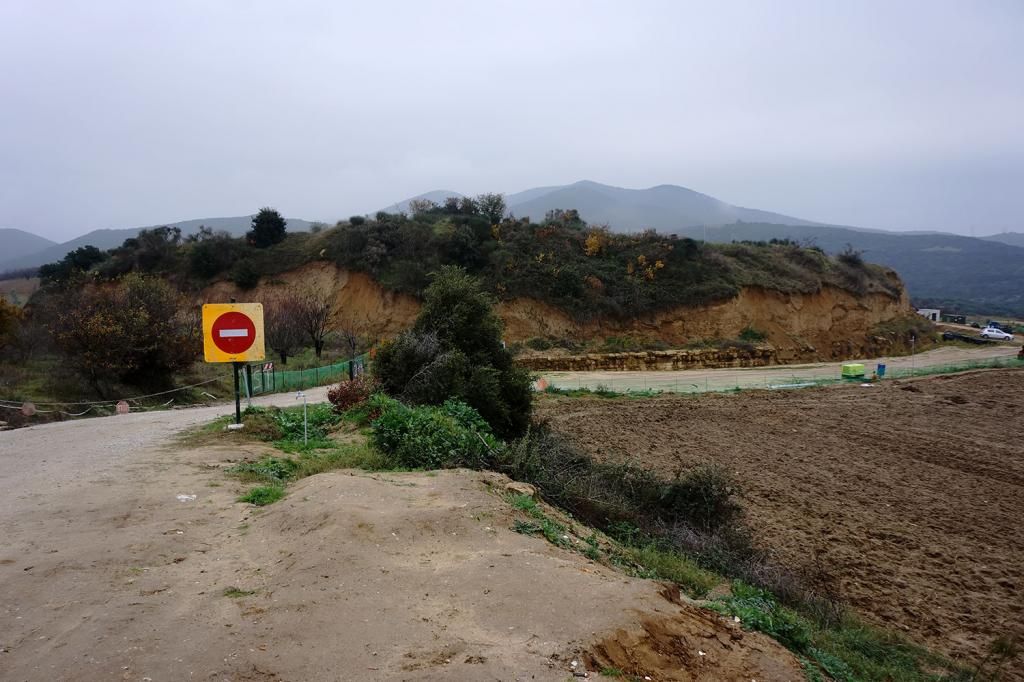
Up a (slippery) dirt road this is the closest that anyone will reach at the excavation site....
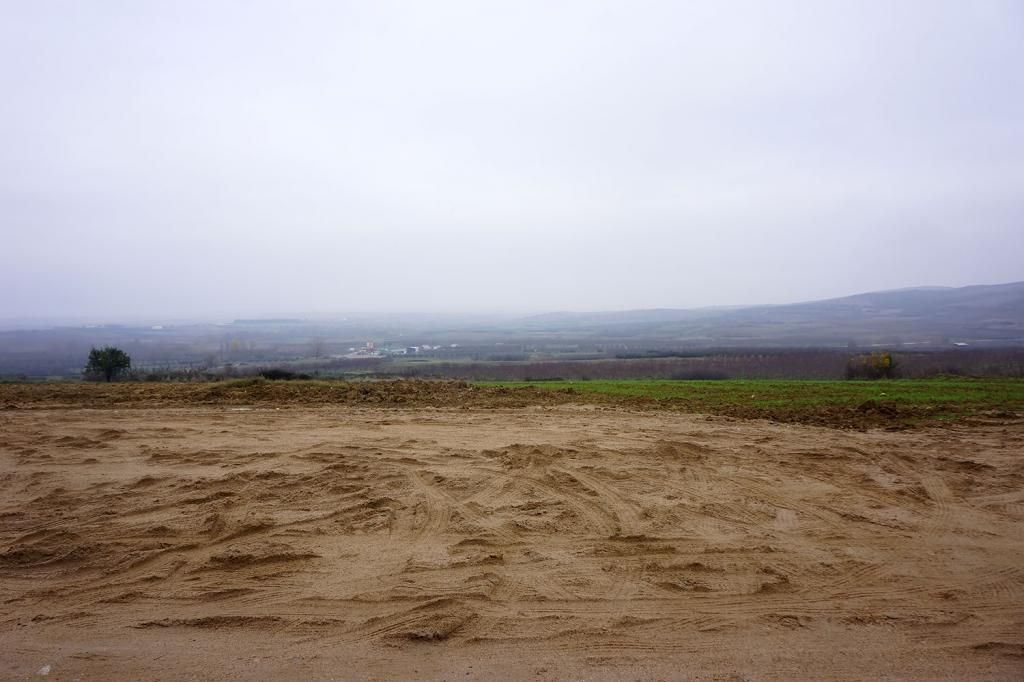
The view just opposite of the site's entrance (West-NorthWest) the valley of Strymonas rvr

The pile of Lazaride's land fills has now been moved out of the tumulus... On your right as you are facing the entrance...
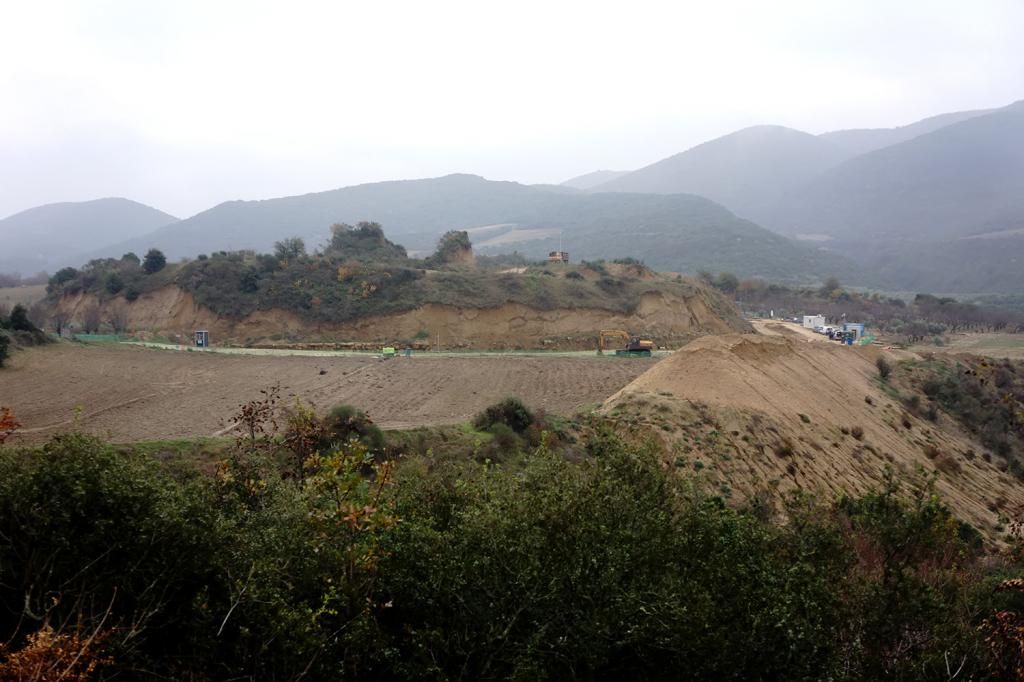
A view from the same direction, just a few hundread yards away. You can just make out the service road that now leads to the entrance of the Monument..
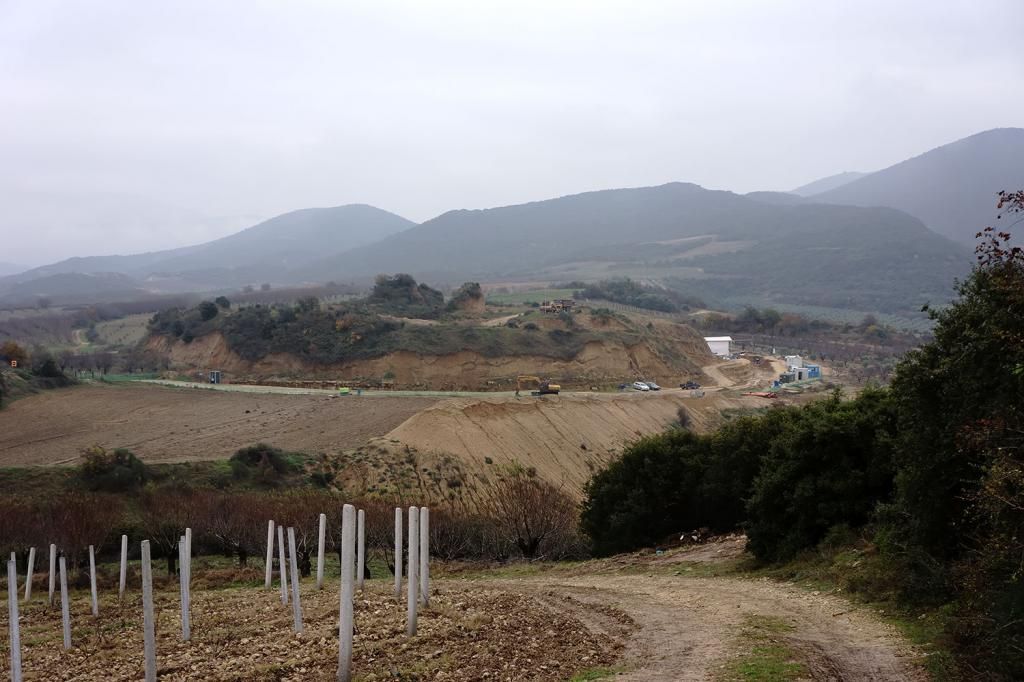
Going up the neighbouring hill, getting a better overall view of the mount. The Monuments entrance is just becoming visible on the right.
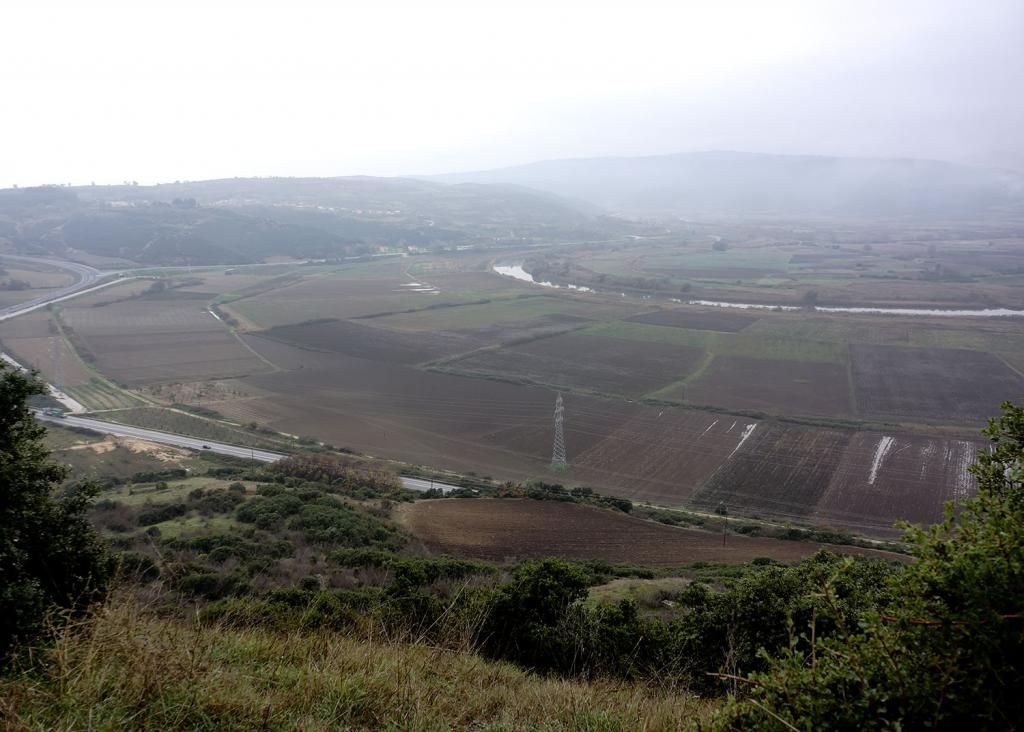
The other side of the neighbouring hill, looking down at the valley and the river Strymon. As you can see, it is a good 80+ meters high, so there is no way a tsunami or a river flood has reached the monument at ANY TIME... On the background, on the hills just off-center on the left, the white "line" is modern Amphipolis... The ancient city lies just above it. The naturally fortified site of the ancient city is clear, looking down on the valley below and the routes that cross there.

The place is of course scattered wt ceramic pieces....
November 17th...

Up a (slippery) dirt road this is the closest that anyone will reach at the excavation site....

The view just opposite of the site's entrance (West-NorthWest) the valley of Strymonas rvr

The pile of Lazaride's land fills has now been moved out of the tumulus... On your right as you are facing the entrance...

A view from the same direction, just a few hundread yards away. You can just make out the service road that now leads to the entrance of the Monument..

Going up the neighbouring hill, getting a better overall view of the mount. The Monuments entrance is just becoming visible on the right.

The other side of the neighbouring hill, looking down at the valley and the river Strymon. As you can see, it is a good 80+ meters high, so there is no way a tsunami or a river flood has reached the monument at ANY TIME... On the background, on the hills just off-center on the left, the white "line" is modern Amphipolis... The ancient city lies just above it. The naturally fortified site of the ancient city is clear, looking down on the valley below and the routes that cross there.

The place is of course scattered wt ceramic pieces....
AAA
Re: The Sphinxes Guarding the Lion Tomb Entrance at Amphipolis

The view up from the valley road (seen at the previous picture showing modern time Amphipolis at the background).
Hill 133 is on the right, the tumulus at the center. Again, the obvious height of the location clearly rules out any "suspended matter" reaching the Monument via flooding, or otherwise...
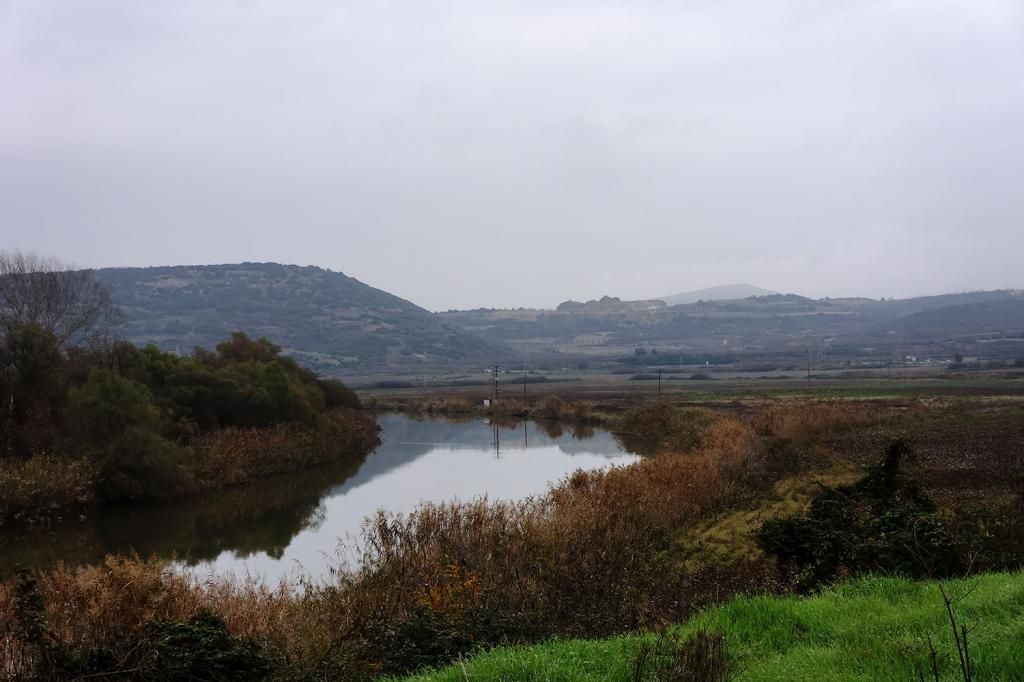
We are now just at site of the ancient Amphipolis bridge (the one Lazarides discovered back in the 70's). Strymonas is just before us, on the left, Amphipolis on the right, but much higher than we're standing. The entrance of the Monument can be just made out on the tumulus (due to the white canvas housing protecting it). I think it is clear that the monument's longitudinal axis aims towards ancient Amphipolis. That is why I think the monument's axis was not pointing towards the center of the tumulus, but was off center. If it did point to the center of the mount, it wouldn't be aligned wt the city. You wouldn't be able to draw a straight line from the inner chamber, exiting between the sphinxes and hitting the ancient city...

Just on the right, on the side of the road, a nice new-classic (ΝΕΟΚΛΑΣΙΚΟ) building houses on of the dept. of the Amphipolis archaeological services..
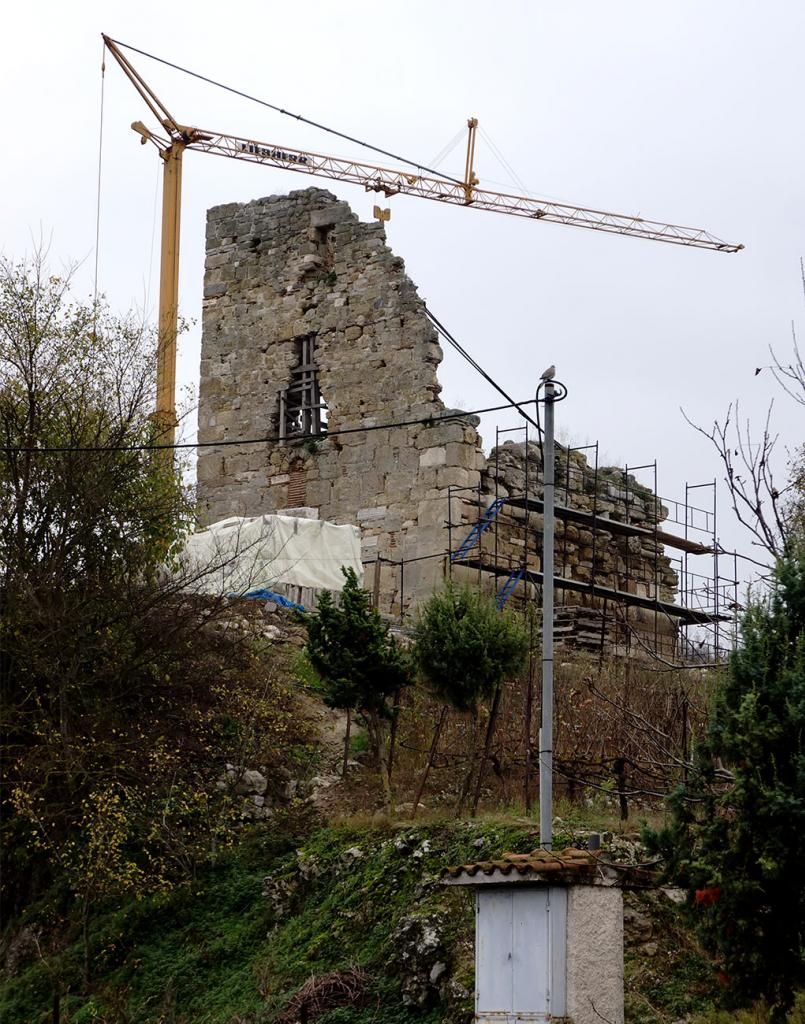
Just on the right of that building, sits a fortified tower build in 1367 to guard the passage over Strymon. The tower was built wt a vast amount of ancient building materials from the surronding area....
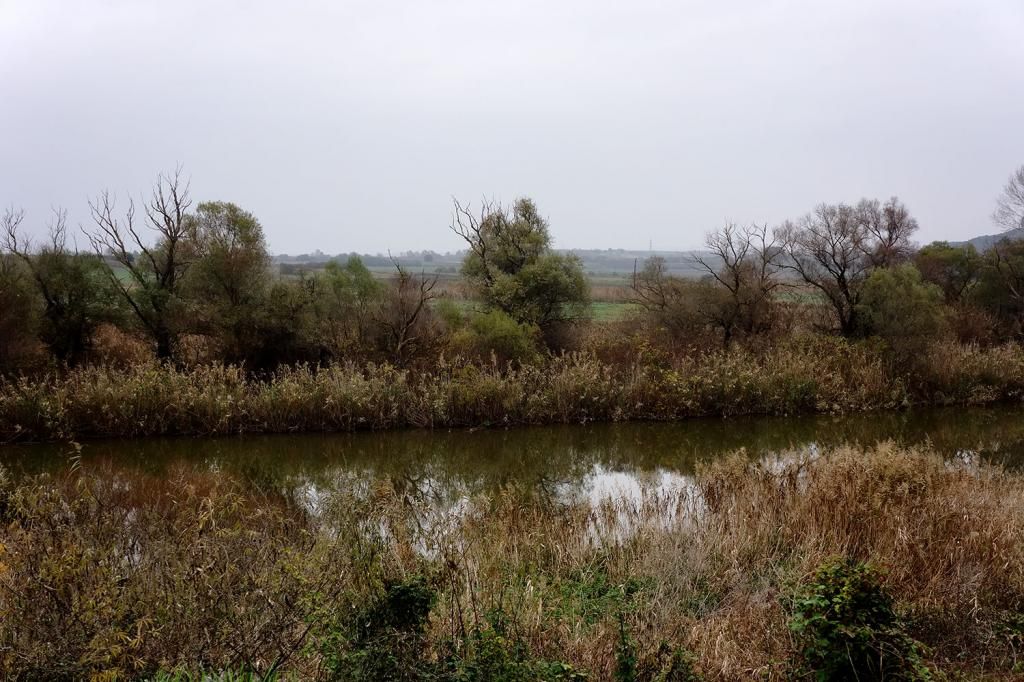
The river Strymon on our left (facing West)
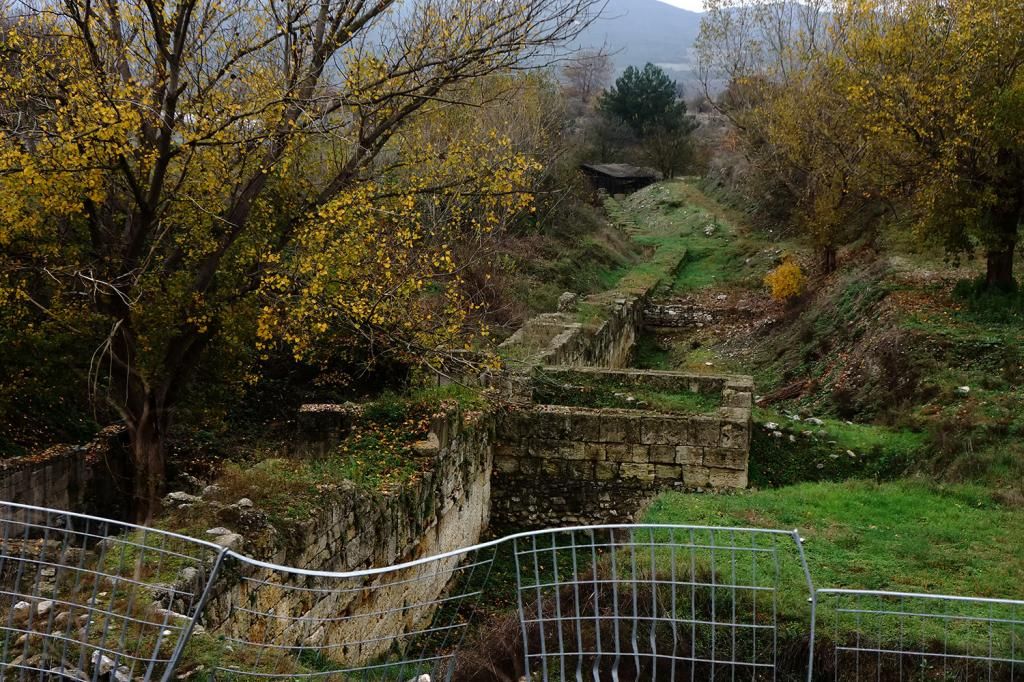
On our back, the ancient fortifications that led to the ancient wooden bridge (it is located under the dark roof at the background)
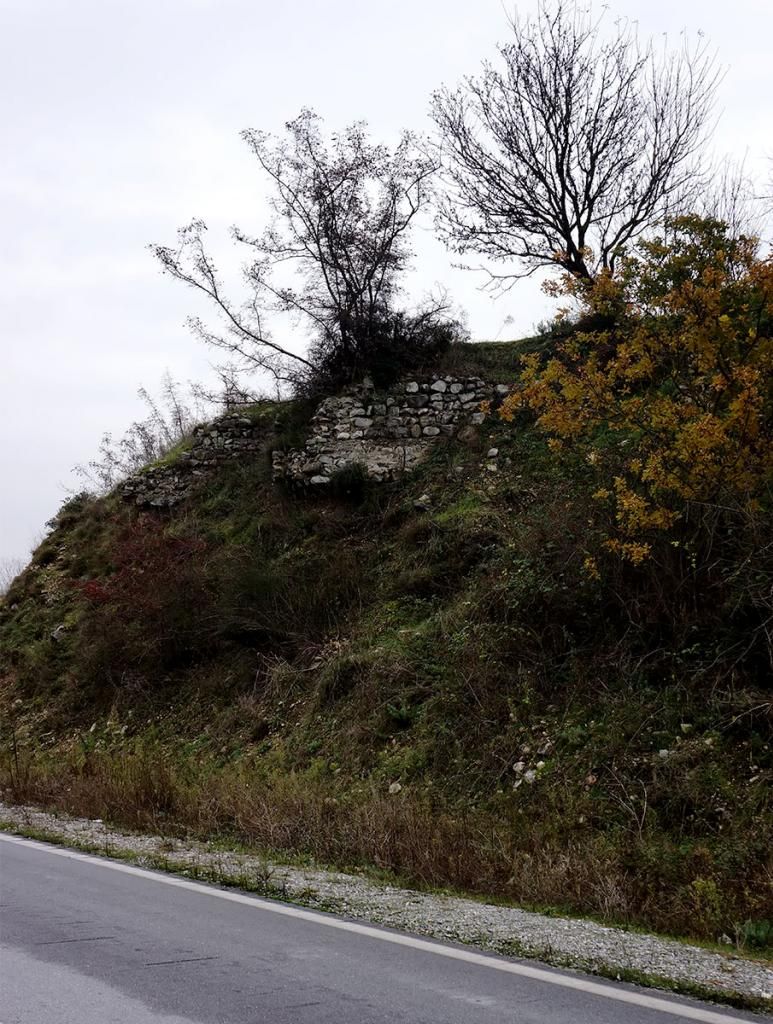
Just after the neoclassic building, on the same side of the modern road, pieces of the ancient city's fortification are sticking out of the ground...
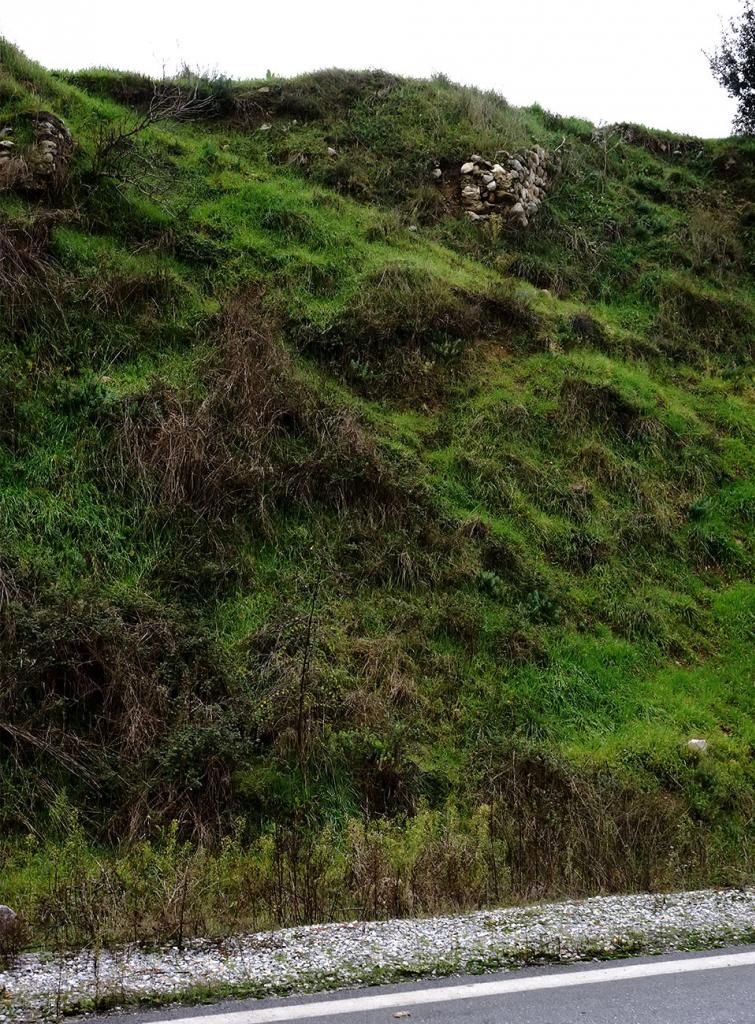
..in more than one places....

the "line" of the fortified wall can be easily made out...
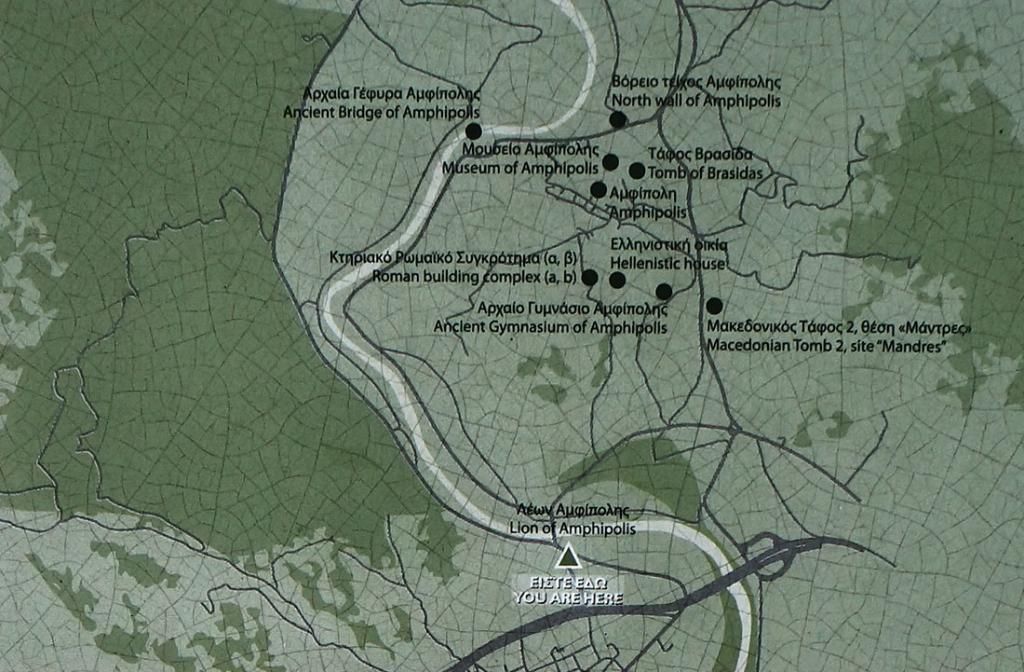
This is actually a picture of the detail from the modern time monument of the Amphipolis Lion.. just showing it here so you can see the topography of some of th eplaces that the above pictures cover (on the upper part of the illustration)
AAA